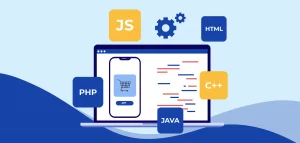Table of content
With so many new developments going around in terms of technology,
business streams have now become varied and multiple. One stream of
business is now divided into several job offering options and more. One
such relatively new aspect of the financial industry is named “FinTech”
or Financial Technology. If you are developing a FinTech App, this is
the right place for you. Here is the 10 mistakes listed below that
should be avoided at all cost in app development. FinTech is that part
of the financial industry that deals with the application of technology
that steers improvements in financial activities.
If used in the right manner, FinTech can help in opening options for
newer applications as well as the services for customers. It also leads to
better and competitive financial technologies being built up. But as it is
a new technology for the industry, there are still amendments going on.
Developers who are building applications around this technology are facing
a lot of issues due to multiple reasons. Keeping in mind that the software
domains like mobile application development and end-user web applications
are extensively used by the customers, a small error or bug will not only
annoy the users, it can also lead to severe financial loss. So here are
the mistakes you have to avoid.
10 Mistakes to be Avoided when Developing a FinTech App
1. Insufficient Testing
For any application, testing is a very important and crucial phase.
Similarly, if you are developing a FinTech App, it is very important for
you to test the application at every stage and a sufficient number of
times. Thorough testing will not only help you in double-checking the
tendency of the application, but will also help you in fixing the bugs
at every stage. This is a very good habit that experienced application
developers have. Another thing that you, as a developer, need to keep in
mind, it is not sufficient to check the application manually, you need
to start inculcating the habit of spot-checking the results to eliminate
the problem.
Also, you need to keep using automated testing, which includes failure
tests, success tests, and a lot of other things. The usefulness and
importance of FinTech applications make it of utmost importance for
developers to test the application a sufficient number of times before
launching. When it comes to FinTech, it is not always the coding that
changes things, the data plays an important role here.
2. Data Filtration is Not Practiced
FinTech being a part of the financial sector, opens up the doors to a
lot of unsensitized data. The data in FinTech applications are pulled
from several sources, with variable formats and undefined quality or
quantity. The financial sector is so deeply rooted in the market that it
can pose a lot of unidentified and undefined bugs for the person who is
developing a FinTech app. You can be looking at data from legacy files
that are pulled up from the mainframe, from a specific database, stock
exchange, or simply the Twitter firehose.
Since data is so extensively networked with each other, it is very
important for the developer to filter, clean, and then use the data that
they pull up for the application. While strictly following or practicing
data filtration, you can evade a lot of bugs, at some places, you can
simply change the unfiltered data by the default values.
3. Fixing the UI
One of the prevailing problems, not just while developing a FinTech app
but several others, are User Interface (UI). One of the main reasons why
developers face this problem is that they don’t decide on the design in
the beginning. Once you have determined the services, the very next
thing that needs to be done is deciding the design of the application.
In order to get an intuitive design of your application, this is a very
important step to be followed. A clean design of any application shows
the clear intention of the developer and the brand it is developed
for.
If your FinTech Application is poorly designed and structured, it will
fall short of customers, and might attract bad reviews as well. You might
not be able to design and place everything in the application, but having
a lucrative user interface is a must for every application.
4. Failing to Maintain Consistency
An application is a brand speaking to its customers. When it comes to
developing a FinTech app, there are lots and lots of things that have to
be considered to keep it in proportion. Failing to maintain consistency
is one of the major factors that has caused developer nightmares. There
should always be a fixed color scheme, lucrative graphics, and
typography as well. If these are missing and your application is all
over the place, it will send a direct message to the customer that the
application and services are inconsistent.
Whatever font, color, or scheme you choose for your application, it
completely depends on you. However, ensure that it is followed throughout
the application without a miss.
5. Keeping it Simple
You might have heard that simple is the best way to ensure your
customers are always there with you. Haven’t you? There are many
developers out there in the market who haven’t heard about this either.
When it comes to developing a FinTech app, the simpler it is, the
better.
Being a finance-related application, no customer wants to keep guessing
things. Therefore, being a developer, it is your responsibility to develop
an application that gives a clear picture to the customers. Along with
that are able to easily access the various sections of the entire
application. If you fill your app with complex fonts and too many landing
pages, there are chances that your customers would not have a good
time.
6. Stay Away from Congestion
There are several applications where developers congest too many things
on a single page. This is a big no-no while you are developing a FinTech
app. As a result, the user may just skip the important part because of
too many things written on the page.
Putting too many elements on the same page would only lead to visual
overload and a bad user experience. Another thing to keep in mind at this
point is that your application should not have disproportionate ratios
between texts and graphics. Doing so will show how amateur your
application is.
7. Not Using the Round Shapes Often
Many developers have the habit of putting a lot of shapes and pointed
shapes in their application. Call it a psychological aspect, but people
fail to process sharp-edged images or angles. On the other hand,
sharp-edged corners of any element on the screen appears to be brighter
than it should be. This leads to mental fatigue (according to leading
psychologists). Therefore, it is always good to have round-shaped images
in your application.
This might look simple, but several developers make this mistake, and
fail to include round-edged elements. Round shaped elements directly
capture the attention of the user and bring it to the content written
inside.
8. Security Approaches
Almost all FinTech applications deal with very sensitive data. It
involves transferring and storing funds and financial data that can be
at risk if the security of the application is not good enough. With so
many hackers already trying to break in through several doors, it is
better to keep your application protected.
To do that, you can provide the users with biometric identification like
fingerprints, facial recognition, and much more. This has become
important, because simply putting up a password is not enough anymore.
Therefore, your application should backed with high-end encryption.
9. Easy Accessibility
Not many developers consider this to be an important element of their
work while creating an application. But if you are developing a FinTech
app, easy accessibility is a crucial and important aspect. Accessibility
is one of those features that can result in a great user experience,
which directly translates to more customers. This is why it is of utmost
importance to integrate good quality features in your application.
10. Mapping the Target Audience
Comparatively, this is a mistake that not all developers make, but when
it comes to FinTech applications, this is a mistake that can’t be
tolerated. Before starting to make your application, it is very
important to analyze and map your target audience. All the application
users interact and use FinTech apps according to their needs and
demands. A developer should put this point high on your list and get it
done without a miss.
Conclusion
Summing up all the 10 points, we get to understand that a successful
and traction-gaining FinTech application should be created after
concluding your research, should have good UX/UI, should be secure and
easy to understand. It is best to trust the leaders when it comes to
avoiding these mistakes. So trust Supersourcing to guide you to the best
FinTech development app
you can make. So that the next time you take up a project, these 10
mistakes are not there on the list.







